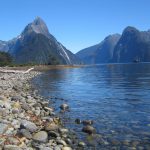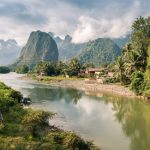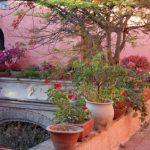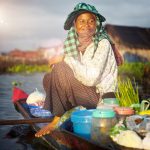 Asif, the mid-thirties grizzly of a man, was driving our office’s green Land Rover rapidly down the sun-baked and vehicle-beaten dirt road. I, the sole foreigner on our trip, assumed the seat of honor (and obligation), shotgun, while my trusted friend and colleague, Torialai sat behind me. Beside him sat Ustad Raqem, the principal of the elementary school which we were journeying to visit. It was July and each of us therefore had shed our customary outer layers of clothing. Men’s clothing in Afghanistan is cyclical: blazers in winter, vests in spring, nothing but the matching tunic and baggy trouser combo for summer, then autumn’s cooler temps allow for the handy multi-pocket vest to return, followed by winter’s blazers. The four of us sat comfortably inside the speeding air-conditioned automobile while the melting sun made mirages atop each hill.
Asif, the mid-thirties grizzly of a man, was driving our office’s green Land Rover rapidly down the sun-baked and vehicle-beaten dirt road. I, the sole foreigner on our trip, assumed the seat of honor (and obligation), shotgun, while my trusted friend and colleague, Torialai sat behind me. Beside him sat Ustad Raqem, the principal of the elementary school which we were journeying to visit. It was July and each of us therefore had shed our customary outer layers of clothing. Men’s clothing in Afghanistan is cyclical: blazers in winter, vests in spring, nothing but the matching tunic and baggy trouser combo for summer, then autumn’s cooler temps allow for the handy multi-pocket vest to return, followed by winter’s blazers. The four of us sat comfortably inside the speeding air-conditioned automobile while the melting sun made mirages atop each hill.
The conversation between the four occupants was full of pleasantries and light meteorological pronouncements: “it’s hot.” My introversive personality and language-overwhelmed brain joined in drawing my attention to the window, to brownish fields framed by brown mountains, to an occasional rolling stream lined with flourishing flora, to child shepherds corralling fluffy black sheep through well-grazed fields. This is Afghanistan, a canvas on which people give the painting its color.
As the journey progressed, our speed gradually slowed as the road narrowed. Abruptly, however, we stopped and I was flung back to the conversation of the three Afghan men: “Cheqa garm shuda. It’s so hot. Tobestan as, neh? It’s Summer, isn’t it?” Ahead of us stood a wood-planked bridge, too narrow for our (or anyone else’s) vehicle to transverse. We each alighted, and leaving Asif with the vehicle, Torialai, Ustad, and myself left on foot. Standing on the bridge and viewing the sandy path twisting ahead, Ustad estimated a twenty minute walk in store for our plastic, chinese-made sandals.
The path unfurled, the light blue sky loomed over us, and the view seemed to be infused with too much sunlight. The mud brown walls of the interspersed homes along our path were bright, Ustad’s white, circular hat almost glowed, and the scattered plant life’s pale green color radiated. At various points during the walk, children would suddenly appear next to us weaving in between the strangers, often first staring blankly at me then revealing my true identity to all within earshot: “Horegi! Foreigner! Cheqa safed as! Look at how white he is!” If the brown dirt road was illuminated by the overactive sun, I was sure I was beyond white to these tan children. Then, with the same suddenness as their appearance, the children would quietly disperse into the scenery, later to be replaced by other equally curious youngsters.
 Twenty minutes finished quickly, at which point the incline of the path increased. No school was in sight and the plump (and now sweating) Ustad explained we were yet thirty minutes from our destination. We continued our walk and at the one hour mark, a scene from Lawrence of Arabia (the one in which the rag-tag band are dragging themselves through the desert) flashed before my eyes. In the all too common yet strange feedback loop, the more I tried to ignore my fatigue and thirst, the greater the sense compounded. Underfoot, the drying sun had mashed the dirt of the road past the consistency of sand to that of powder which each step released like Neil Armstrong’s first step. I too was a first, or at least one of the first Westerners to have walked down this path. And as these thoughts entered into my mind, a thin black cow complete with bell began walked beside me and was quickly driven away by its young caretaker.
Twenty minutes finished quickly, at which point the incline of the path increased. No school was in sight and the plump (and now sweating) Ustad explained we were yet thirty minutes from our destination. We continued our walk and at the one hour mark, a scene from Lawrence of Arabia (the one in which the rag-tag band are dragging themselves through the desert) flashed before my eyes. In the all too common yet strange feedback loop, the more I tried to ignore my fatigue and thirst, the greater the sense compounded. Underfoot, the drying sun had mashed the dirt of the road past the consistency of sand to that of powder which each step released like Neil Armstrong’s first step. I too was a first, or at least one of the first Westerners to have walked down this path. And as these thoughts entered into my mind, a thin black cow complete with bell began walked beside me and was quickly driven away by its young caretaker.
Finally the summit of the gradual incline was reached and we entered the courtyard of a U-shaped, weather-worn concrete school building. Each room was empty and bare, many missing window panes and doors. Though this school had an advantage because of its construction (many classes elsewhere simply meet in tents) even most tent schools have benches. Ustad directed us into one of these concrete rooms where the guard of the empty structure unfurled a carpet to shield us from the floor as we sat. The school’s principal and our host beckoned the guard to bring us each refreshment from our long, hot walk. The guard promptly sent a young boy, who had suddenly appeared next to him, on the errand.
At the dispatch of the boy my heart leapt with joy. My languished body conjured images for my mind of cool liter bottles of water being carted into the room by the wheel-borough-full. We sat, largely in silence, in anticipation of the boy’s return while visually inspecting the empty room from the floor. The devoid rooms we were occupying were the planned future destinations of newly created wooden benches for the school’s students. I stared into the concrete cube and imagined a replete classroom of eager to learn students sitting on the edge of nicely constructed benches, each holding a pencil in one hand and a bottle of cool water in the other. They were smiling at me. I was smiling at them.
And the boy returned with a turban slung over his shoulder like a knapsack. I was salivating when he stood at the edge of the carpet and swung the blue and white checkered fabric into the center of the four men (the guard was now seated with us). Inside the now tablecloth of a turban arose a pile of cucumbers, large, green cucumbers. Dismay and disbelief dropped out of my dumbfounded and open mouth as Ustad respectfully prepared the vegetable in the proper, customary method: slicing off the end of the vegetable then rubbing the newly separated pieces together until a white foam is created. He then passed it bit by bit to his guests. I sat in silent disappointment holding a foamy cucumber while Ustad, Torialai, and the guard relished the refreshing green vegetable.







Leave a Reply